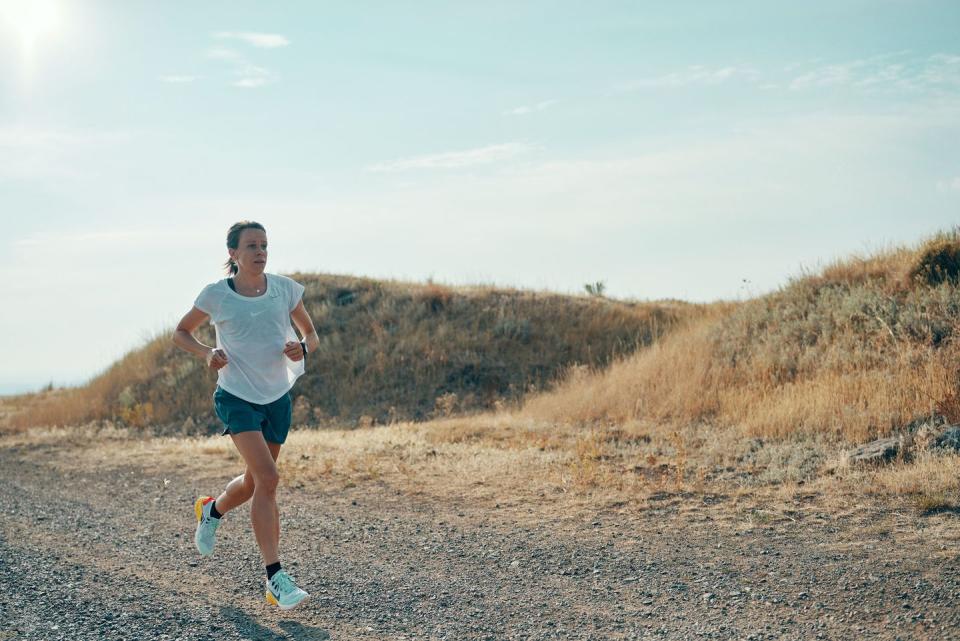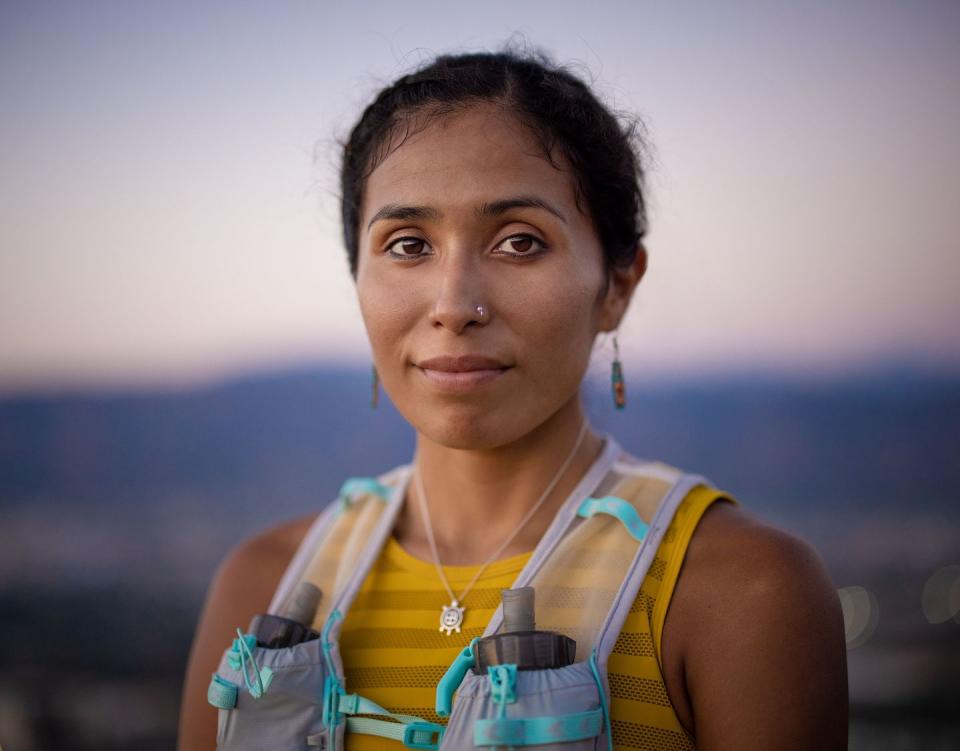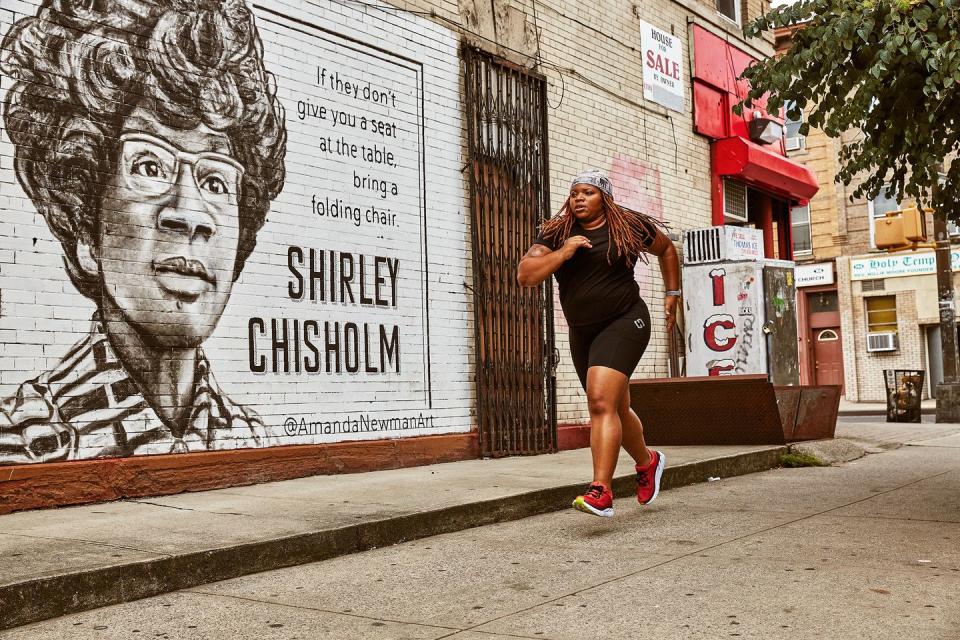Running Isn’t Safe Unless It’s Safe for Everyone


The last time professional trail runner Addie Bracy feared for her safety, she was on a run with her girlfriend, Corey Conner. The couple was logging miles together in the dark when they paused at a stoplight, where Bracy gave Conner a hug and a kiss. A woman pulled her car alongside them and gave them the worst look Bracy had ever seen. “[It was] just disgust,” Bracy says. “She shook her head at us like she was disappointed.”
The encounter left Bracy feeling vulnerable and uncomfortable. She realized she wanted to take action. “Women’s safety is already a big issue,” Bracy says.
According to a 2019 Runner’s World survey, 84 percent of women have been harassed while running. “But when you add any kind of extra layer of ‘other,’ it increases the likelihood of something happening,” she says.
Groups that typically experience discrimination—including LGBTQ+ and BIPOC people—often don’t feel safe while running. In the fall of 2019, we partnered with Women’s Health and HOKA ONE ONE to create the Runners Alliance, a powerful initiative that offers concrete, real-time solutions to reduce harassment and improve the safety of the places we run.
There’s more work to be done. As the world and running have awakened to the way underrepresented communities are more vulnerable to harassment and violence, our focus this year is to develop programming centered around diversity and inclusion with the end goal of making running safer for everyone. We’ve partnered with influential women in the running community who are as dedicated to finding solutions as we are. By bringing in leaders who are committed to improving runner safety, increasing representation, fighting for inclusion, and empowering individuals within the running community, the Runners Alliance seeks to help women and all people who experience harassment reclaim their run.
Meet the five ambassadors as they share their plans for making a difference as part of the Runners Alliance.


Addie Bracy Celebrates LGBTQ Runners
For Addie Bracy, running is a source of empowerment and community, which was critical for her in the years before she came out as LGBTQ+.
“No matter what was going on or how much I felt like I wasn’t being authentic in my life, in running I have always felt like the purest form of myself,” Bracy says.
After a frustrating 2016 professional track season, Bracy decided to come out on a public platform for the first time. Now, along with her partner Corey Conner, she helps other LGBTQ+ individuals find empowerment and connection through running.
“We want to use our last few years in the sport to make a difference, and hopefully leave it better than it was when we got here,” Bracy says.
Bracy and Conner started a nonprofit called OUTrun in May 2019, which connects and supports LGBTQ+ individuals through group runs, collaboration with race directors, and a large ambassador network. The goal is to empower LGBTQ+ people within the running community and encourage members of the LGBTQ+ community to embrace the sport.
And on a personal level, Bracy and Conner made the decision to be visible as members of the LGBTQ+ running community. For example, if Conner is on Bracy’s support team during an ultra race, Bracy will give her a kiss at the aid station. It may seem like a small gesture, but it sends a message of inclusion and acceptance for LGBTQ+ runners. The couple often receives emails and messages from people thanking them for their openness, which inspires more LGBTQ+ individuals to show up fully within the running community.
“The number of emails we got signifies to me there probably are a lot of LGBTQ+ people in the running community who maybe just aren’t open about it,” Bracy says. “We want to keep spreading that message of courage to be yourself and be comfortable in that space.”
In addition to forming OUTrun chapters in cities around the country, Bracy and Conner are working with race directors to generate awareness and develop more inclusive policies at events to create a more welcoming environment for LGBTQ+ runners.
They ask race promoters a series of questions. “Are you promoting your event, brand, or race in a way that feels inclusive to everyone?” Bracy says. “That could be the registration process and gender identification options, transgender policies, really anything that shows an open-arms approach to any kind of runner.”
Bracy hopes to foster collective empowerment within the running community so women and those in marginalized groups can run without feeling afraid.
“When you talk about the issues and challenges, you don’t want the result to be fear,” Bracy says. “You want the result to be empowerment and strength.”


Jordan Marie Brings Three White Horses Daniel Wants Justice for Indigenous Women
At the 2019 Boston Marathon, Jordan Marie Brings Three White Horses Daniel had a goal beyond just a time on the clock: She was running to call attention to the epidemic of Missing and Murdered Indigenous Women (MMIW). On some reservations, Indigenous women are 10 times more likely to be murdered than the national average, according to Justice Department data. With a red painted handprint over her mouth to represent the women silenced by violence, and the letters MMIW painted on her body, Daniel said a prayer every mile for a different victim.
“I felt so proud and so honored to be able to run for those 26 women and for my grandfather,” Daniel says. “None of it had anything to do with me. I just had to provide the body to run those miles. That was the very least that I could do.”
Since then, Daniel has continued to run for justice. Through these efforts, Daniel has raised awareness, brought in allies, rallied support, and pursued solutions to the crisis of Indigenous people who have been silenced by violence.
As a fourth-generation Indigenous runner, distance running has always connected Daniel to her family. Her grandfather, Nyal Brings Three White Horses, ran for the University of South Dakota and her mother, Terra Beth Brings Three White Horses Daniel, was an accomplished sprinter who was training for the 1988 Olympic Trials until she learned she was pregnant with Daniel. In high school, the Kul Wi?asa Lakota athlete wanted to continue the legacies of her mother and grandfather and share in that family history, and ultimately she earned a spot on the track team at the University of Maine.
In the years after college, Daniel began to participate in prayer runs—a practice in which runners honor, support, and interact with lands—organized by groups of Indigenous tribes who raised awareness about environmental and human rights issues, like the protection of Bears Ears National Monument in Utah and the MMIW epidemic. Since she was a child, Daniel wanted to advocate for her people and fight for a better future for the next generation. She works as a consultant for native tribal communities, where she focuses on community development through environmental and energy sustainability, access to quality healthcare, and more. And she started the Rising Hearts Coalition, a grassroots group that supports and defends Indigenous community rights.
For years, she kept her competitive and activist sides separate, until the lack of national visibility for MMIW became too difficult to bear. That’s when she decided to dedicate her Boston Marathon to the cause.
“It felt exhausting that so much work was going into this movement to find answers and solutions and justice, and it still was not getting any sort of attention,” she says. “No one cared about the deaths and murders and disappearances of Indigenous women and our relatives. That’s when I took the opportunity to run in prayer, run for them rather than for me.”
By running for justice, Daniel hopes to create a better future for Indigenous people, the BIPOC community, LGBTQ+, two-spirit, and non-binary individuals so that members of marginalized groups are represented and respected.
“I believe we can have a better world that is more inclusive and diverse and more supportive,” Daniel says.


Carolyn Su Spotlights Underrepresented Athletes
Carolyn Su has devoted her life to supporting underrepresented groups, whether it’s showing up as a female in a male-dominated work space and speaking up for women, or sharing the perspective of Asian Americans at her children’s school or sports activities.
“That’s my mindset,” Su says. “For our whole life, we bear a responsibility to advocate for voices that are minimized, ignored, or unheard.”
After noticing a lack of BIPOC representation in running media, brands, and groups, Su reached out to several influential podcast hosts in the running community and asked them to consider covering a more diverse range of athletes. In the conversations that followed, it became clear to Su that creating a more inclusive environment was not a priority for most. In response, she decided to build her own platform. She launched the Diverse We Run Instagram account in 2018 to elevate the experiences of the BIPOC runners. In weekly posts, she features a runner from the BIPOC community and shares their journey to running.
“[Representation] helps to broaden our worldview, but then it also helps each person dream bigger and know that they’re not alone in the struggles or the challenges they face, and that their experience is valid,” Su says. “We all benefit collectively when each person individually is able to show up fully in all aspects of who they are.”
Since launching Diverse We Run two years ago, Su has collaborated with followers on community events, amplified fellow BIPOC platforms, fostered discussion about building representation, been interviewed on several running podcasts, and made lasting connections with runners around the country. She’s also received countless messages thanking her for featuring BIPOC runners.
By sharing these unique stories, Su hopes to make runners of different ethnic, cultural, and racial groups feel welcome.
Su also hopes to encourage more BIPOC individuals to feel empowered to be themselves, which she believes will create a safer atmosphere within the running space. To emphasize the significance of representation, Su quotes Marian Wright Edelman: “‘You can’t be what you can’t see,’” she says. “It’s work that happens within the minority right now, but it’s also work that needs to happen by the majority of people who are more predominantly represented in the sport.”
“[In running media, marketing, and groups] I want runners who are not just that main image of a thin, white runner,” Su says. “I want runners who don’t often see themselves as represented to be able to feel like they can show up at a running store or a running group and they belong.”


Claire Green Advocates for Change in the Elite Ranks
Growing up in a predominantly white neighborhood in Louisville, Colorado, Claire Green and her brother were often the only Black kids in their classes and sports teams, which meant learning to deal with subtle acts of discrimination nearly every day.
“We were taught to try and educate when possible,” Green says. “Because when you express distaste or frustration with microaggressions, oftentimes you get labeled as the angry Black woman or as violent, unstable.”
When she joined the track team in middle school, Green assumed she’d be a sprinter because she rarely saw Black women distance runners. But her coaches recognized Green’s talent for endurance and encouraged her to try the mile and longer events, which is ultimately where she excelled. After winning three Colorado state titles, she earned a spot on the University of Arizona track-and-field team, where she became an All-American in cross country and the indoor mile.
“I cannot emphasize enough how useful and reassuring that [representation] would have been for me as a young runner growing up,” Green says. “I might not be the fastest woman out there, but I hope that I can be a role model and an example for other girls who do look like me and feel like they might not fit in the sport.”
After years of feeling like she didn’t belong and dealing with microaggressions in mostly white spaces, Green decided it was time to speak up about the lack of representation on the track. Now in her second year as a professional runner for the HOKA ONE ONE Aggies, Green recently became a contributing writer for RUNGRL, a digital media and event platform for Black women runners.
“My ultimate goal is to educate as many people as possible, and influence them to impact positive change in their own communities,” Green says. “Unless people really understand the root of all of these movements and why this affects everybody, it’s not really going to have any impact.”
Through her writing and by sharing resources for the Black Lives Matter movement on social media, Green is urging the elite running community to increase representation and empower more runners of color to feel welcome in the sport.


Latoya Shauntay Snell Demands Space for All Bodies
When Latoya Shauntay Snell ran the New York City Marathon in 2017, she expected the final miles of the race to be difficult. But she didn’t expect the type of challenge she’d encounter: Between miles 22 and 23, she was heckled by a stranger who shouted, “It’s going to take your fat ass forever, huh?” among other insults. The experience was jarring, upsetting, and dehumanizing. But it led her to find allies in the running community when she needed them most.
After she crossed the finish line in New York City, Snell turned the experience into a source of power with an essay on the online magazine The Root that went viral. In response, she discovered fellow runners who empathized with her and felt empowered to share their stories. Their vulnerability helped Snell discover strength she didn’t know she had.
“I don’t think I would understand the power of my voice if it wasn’t for the running community. Other people saw things in me that I couldn’t accept in myself,” Snell says. “They helped me understand how strong and courageous and brave I am.”
The response ultimately inspired Snell not only to keep running, but to use her voice to support women and members of marginalized communities.
She stresses the importance of body politics, which means acknowledging that everyone’s body is different and respecting those unique experiences. “It’s embodying that you are beautiful—whether that’s physical beauty, mental beauty, emotional beauty, or the things that fall in between—and honoring the body you’re in at this present moment, not acknowledging the one that exists in the past or the one that you may be trying to attain in the future,” Snell says.
In advocating for body politics, Snell calls attention to the battles we fight that others may not be able to see, including disabilities. As someone living with endometriosis—a painful disorder characterized by abnormal tissue growth outside the uterus, which results in heavy and irregular periods and sometimes fertility problems—Snell wants to create more awareness for runners who live with disabilities.
For example, she completed the last half of the 2019 New York City Marathon while suffering from an endometriosis flare-up during her period. With blood running down her legs, Snell ran the race in excruciating pain in front of thousands of people.
Snell shared her experience, tips for training and racing, and recommendations for dealing with endometriosis on her blog Running Fat Chef.
“I am much more than just the disability that I have,” Snell says. “I’m so much more than the things that we can see and cannot see. I just hope that we can learn how to respect each other’s differences.”
You Might Also Like